Charlotte, North Carolina Blood Testing Facilities
 Represents a LabCorp blood testing facility
Represents a LabCorp blood testing facility Represents a Quest Diagnostics blood testing facility
Represents a Quest Diagnostics blood testing facility
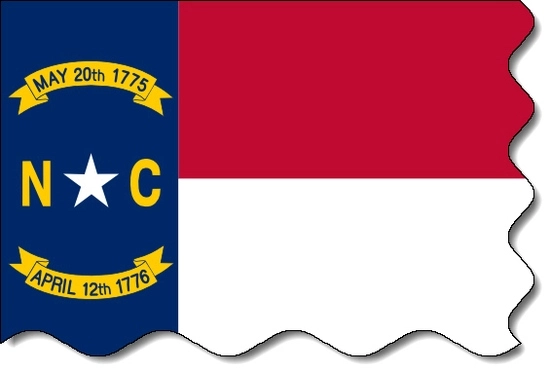
Nearby Labcorp Blood Testing facilities:
- Labcorp Center Distance: 1 m, 1718 East 4Th Street Ste 302, Charlotte, Mecklenburg County, NC, 28204
- Labcorp Center Distance: 3 m, 300 Billingsley Rd Ste 200A, Charlotte, Mecklenburg County, NC, 28211
- Labcorp Center Distance: 7 m, 8401 Medical Plaza Dr. Ste 140, Charlotte, Mecklenburg County, NC, 28262
- Labcorp Center Distance: 8 m, 10320 Mallard Creek Road 180, Charlotte, Mecklenburg County, NC, 28262
- Labcorp Center Distance: 9 m, 10512 Park Rd Ste 107, Charlotte, Mecklenburg County, NC, 28210
- Labcorp Center Distance: 10 m, 1500 Matthews Twnshp Pkwy1147, Matthews, Mecklenburg County, NC, 28105
- Labcorp Center Distance: 11 m, 15830 Ballantyne Med Pl Ste140, Charlotte, Mecklenburg County, NC, 28277
- Labcorp Center Distance: 12 m, 10030 Gilead Road Ste 100-B, Huntersville, Mecklenburg County, NC, 28078
- Labcorp Center Distance: 14 m, 16525 Holly Crest Lane 250, Huntersville, Mecklenburg County, NC, 28078
- Labcorp Center Distance: 17 m, 640 Summit Crossing Pl Ste 206, Gastonia, Gaston County, NC, 28054
- Labcorp Center Distance: 20 m, 2460 India Hook Rd Ste 101, Rock Hill, York County, SC, 29732
- Labcorp Center Distance: 22 m, 134 Medical Park Rd Ste 102, Mooresville, Iredell County, NC, 28117
- Labcorp Center Distance: 35 m, 800 W Meeting St, Lancaster, Lancaster County, SC, 29720
- Labcorp Center Distance: 37 m, 601 Mocksville Ave Ste B, Salisbury, Rowan County, NC, 28144
- Labcorp Center Distance: 39 m, 1710A Davie Ave, Statesville, Iredell County, NC, 28677
- Labcorp Center Distance: 43 m, 1949 Tate Blvd Se, Hickory, Catawba County, NC, 28602
- Labcorp Center Distance: 45 m, 1530 N Limestone St, Gaffney, Cherokee County, SC, 29340
- Labcorp Center Distance: 60 m, 7122 Village Medical Circle, Clemmons, Forsyth County, NC, 27012
- Labcorp Center Distance: 61 m, 137 Mt. Calvary Road Suite B, Thomasville, Davidson County, NC, 27360
- Labcorp Center Distance: 64 m, 391 Serpentine Dr Ste 101, Spartanburg, Spartanburg County, SC, 29303
- Labcorp Center Distance: 65 m, 3333 Brookview Hills Ste 103, Winston Salem, Forsyth County, NC, 27103
- Labcorp Center Distance: 66 m, 1902 West Park Drive, North Wilkesboro, Wilkes County, NC, 28659
- Labcorp Center Distance: 67 m, 610 N Fayetteville St. Ste 110, Asheboro, Randolph County, NC, 27203
- Labcorp Center Distance: 68 m, 1350 Haile St, Camden, Kershaw County, SC, 29020
- Labcorp Center Distance: 72 m, 942 Johnson Ridge Road Ste U, Elkin, Surry County, NC, 28621
- Labcorp Center Distance: 74 m, 3610 Peters Court Suite 200, High Point, Guilford County, NC, 27265
- Labcorp Center Distance: 75 m, 445 Pineview Dr Ste 210, Kernersville, Forsyth County, NC, 27284
- Labcorp Center Distance: 77 m, 120 Highland Ctr Dr Ste 130B, Columbia, Richland County, SC, 29203
- Labcorp Center Distance: 78 m, 8 Regional Circle, Pinehurst, Moore County, NC, 28374
- Labcorp Center Distance: 80 m, 237 Longvue Drive Ste C, Boone, Watauga County, NC, 28607
- Labcorp Center Distance: 81 m, 1 Wellness Blvd Ste 105, Irmo, Lexington County, SC, 29063
- Labcorp Center Distance: 84 m, 1126 N Church St Ste 104, Greensboro, Guilford County, NC, 27401
- Labcorp Center Distance: 85 m, 2100 Gervais St Ste B, Columbia, Richland County, SC, 29204
- Labcorp Center Distance: 87 m, 752 S Andy Griffith Pkwy, Mount Airy, Surry County, NC, 27030
- Labcorp Center Distance: 89 m, 25 Woods Lake Rd Ste 222, Greenville, Greenville County, SC, 29607
- Labcorp Center Distance: 91 m, 1508A N Cashua Dr, Florence, Florence County, SC, 29501
- Labcorp Center Distance: 92 m, 409 Mills Ave Ste 203, Greenville, Greenville County, SC, 29605
- Labcorp Center Distance: 93 m, 144 Garrett St Ste B, Sumter, Sumter County, SC, 29150
- Labcorp Center Distance: 94 m, 1133 Carthage Street Unit De, Sanford, Lee County, NC, 27330
- Labcorp Center Distance: 95 m, 1690 Westbrook Avenue, Burlington, Alamance County, NC, 27215
- Labcorp Center Distance: 96 m, 855 Heather Rd, Burlington, Alamance County, NC, 27215
- Labcorp Center Distance: 99 m, 7 Mcdowell St Ste 100, Asheville, Buncombe County, NC, 28801
Nearby Quest Blood Testing facilities:
- Quest Center Distance: 3 m, 3541 Randolph Rd Ste 110, Charlotte, Mecklenburg County, NC, 28211-1082
- Quest Center Distance: 9 m, 11111 Carmel Commons Blvd, Charlotte, Mecklenburg County, NC, 28226-4075
- Quest Center Distance: 37 m, 611 Mocksville Ave, Salisbury, Rowan County, NC, 28144-2738
- Quest Center Distance: 39 m, 509 Brookdale Dr, Statesville, Iredell County, NC, 28677-4107
- Quest Center Distance: 43 m, 1781 Tate Blvd South East, Hickory, Catawba County, NC, 28602-4218
- Quest Center Distance: 66 m, 200 Charlois Blvd, Winston Salem, Forsyth County, NC, 27103-1536
- Quest Center Distance: 83 m, 3010 Farrow Rd, Columbia, Richland County, SC, 29203-7603
- Quest Center Distance: 84 m, 1002 N Church St, Greensboro, Guilford County, NC, 27401-1448
- Quest Center Distance: 87 m, 430 Roper Mountain Road, Greenville, Greenville County, SC, 29615-4243
- Quest Center Distance: 99 m, 417 Biltmore Ave, Asheville, Buncombe County, NC, 28801-4541
Charlotte Hormone Replacement Therapy Services
How much do you know about your hormones? Did you know that Hormone Balance is one of the most important aspects of staying healthy and living well? The Conscious Evolution Institute understands that, and we are a Licensed and Board Certified Hormone Clinic devoted to providing quality Hormone Therapy options to patients all throughout the Charlotte metropolitan area.
We have streamlined the process of Hormone Deficiency diagnosis and treatment, and all you have to do is show up to a single appointment with one of our affiliates in your area. They will provide a routine physical to assess your health state, and take a blood sample which will be thoroughly tested regarding a variety of markers for general and hormone health. If our analysis finds that you can benefit from Hormone Treatment, we can discuss your options with you and help you pick a therapy regimen which works for you.
We work with quality online pharmacies and are able to provide you with incredibly competitive pricing for HRT Products and Services and we can deliver them directly to your door. Call us to find out more!
Charlotte Testosterone Therapy for Andropause
One of our flagship products at the Conscious Evolution Institute is Testosterone Replacement Therapy. Low-T is a medical condition which seriously impacts the health of men and women across the United States. Men with Low-T are more likely to experience a variety of chronic and dangerous health conditions, including Hypertension, Diabetes, Stroke, and Alzheimer's. Testosterone Deficiency also directly leads to depression, sexual dysfunction and lack of libido which can seriously endanger your passion and your love life.
Testosterone is also associated with an increased risk of frailty, as muscle mass declines and body fat percentage starts to increase. If our tests show that you are suffering from Testosterone Deficiency, we can prescribe you with Testosterone Creams, Injections, or Patches to alleviate the symptoms of your condition and help you improve your health and quality of life. Don't live with Testosterone Deficiency, talk to a doctor and get the health you deserve.
Charlotte Human Growth Hormone Replacement Therapy for HGH Deficiency
In addition to Testosterone Therapy, our clinic also offers Bio-Identical HGH for the treatment of Human Growth Hormone Deficiency. Low-T may be a more well-known medical affliction, but HGH Deficiency can be just as serious as Testosterone Deficiency. Both men and women need Human Growth Hormone, and are healthier when HGH Levels are at peak adult levels. During childhood, Human Growth Hormone is responsible for growth, but in adulthood, the hormone is responsible for maintaining and optimizing function through its effects upon cellular metabolism.
If you've noticed a lack of energy, combined with unexplained changes in body composition, you may be suffering from Growth Hormone Deficiency. The condition also impacts Bone Mineral Density, which increases the risk of Osteoporosis. Growth Hormone Deficiency is also associated with an increased risk of Alzheimer's and general cognitive decline. If our tests indicate that you have HGH Deficiency, we can get you the Injectable HGH Therapy that you need!
Charlotte Sermorelin HGH Replacement Therapy
Growth Hormone Therapy is not the only option available to patients with HGH Deficiency however, and many patients may benefit more from another treatment known as Sermorelin Acetate Therapy. Sermorelin has the ability to naturally stimulate the production of real HGH by the pituitary, thereby encouraging healthy Growth Hormone Levels in a more streamlined pattern than Injectable HGH.
Sermorelin is a cost-effective alternative to HGH which is just as or more effective than Human Growth Hormone Therapy. Also, Sermorelin can be prescribed Off-Label, which means that your doctor has more freedom to provide you with treatment based upon his or her personal expertise.
Charlotte HCG Injections for Weight Loss
Not all of the Hormone Treatments we provide are strictly designed for restoration. HCG Therapy, for example, is a highly effective weight loss treatment designed to encourage rapid weight loss by simultaneously reducing feelings of hunger and optimizing metabolism. When combined with Caloric Restriction, HCG Injections have been shown to help patients lose up to thirty pounds in a month without feeling fatigued or overly hungry. Before turning to potentially dangerous surgical procedures, talk to our clinical specialists about HCG Weight Loss Therapy.
Charlotte, North Carolina Information
Charlotte is the most populous city in the state of North Carolina, and is the sixteenth largest city in the United States. The city is located in central-southwest North Carolina, to the south of Tobacco Road, the home of both Duke and the University of North Carolina. Charlotte is a major financial center for the East Coast, as well as the entire United States. Charlotte is considered second only to New York City with regard to its importance to the financial industry. One of the largest financial companies in the country is headquartered in Charleston—Bank of America.
The city's importance as a financial center also draws many businesses and corporations to the city and the metropolitan area. There are a number of Fortune 500 companies located in Charlotte, including Family Dollar, Sonic Automotive, Duke Energy, and NuCor, in addition to aforementioned Bank of America. Although Tobacco Road has the most well-known colleges in the state, there are a number of colleges and universities in Charleston, including UNC-Charlotte, Johnson C. Smith University, and Davidson. Davidson is actually considered one of the premier Liberal Arts Colleges in the entire United States.
Charlotte has a modest presence in national professional sports and is home to the Charlotte Hornets and the Carolina Panthers, in addition to a variety of lower level sports teams such as the Charlotte Knights baseball team and the Charlotte Checkers hockey team. Charlotte has a lot of landmarks and museums that draw visitors to the city, including the NASCAR Hall of Fame, the Mint Museum, and the Bechtler Museum of Modern Art. The city also strongly promotes the arts, and there are a number of performing arts centers and troupes active in the city, such as the North Carolina Dance Theater, the Carolina Symphony Orchestra, and the Blumenthal Performing Arts Center.
All About Charlotte, North Carolina Geographic Area
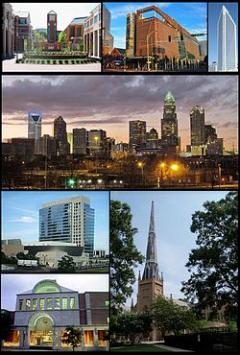

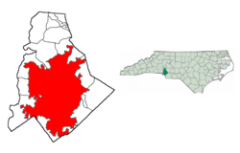
Charlotte ( /ËnÊcÉarlÉot/) is the largest city in the U.S. state of North Carolina and the seat of Mecklenburg County. In 2011 the estimated population of Charlotte according to the U.S. Census Bureau was 751,087, making it the 17th largest city in the United States based on population. The Charlotte metropolitan area had a 2010 population of 1,758,038. The Charlotte metropolitan area is part of a wider thirteen-county labor market region or combined statistical area with a 2010 U.S. Census population of 2,402,623. Residents of Charlotte are referred to as "Charlotteans".
/ËnÊcÉarlÉot/) is the largest city in the U.S. state of North Carolina and the seat of Mecklenburg County. In 2011 the estimated population of Charlotte according to the U.S. Census Bureau was 751,087, making it the 17th largest city in the United States based on population. The Charlotte metropolitan area had a 2010 population of 1,758,038. The Charlotte metropolitan area is part of a wider thirteen-county labor market region or combined statistical area with a 2010 U.S. Census population of 2,402,623. Residents of Charlotte are referred to as "Charlotteans".
The city is a major U.S. financial center, the second largest financial center by assets following New York City. Bank of America and the East Coast operations of Wells Fargo are headquartered in the city. Charlotte is also home of the Carolina Panthers of the National Football League, the Charlotte Bobcats of the National Basketball Association, the NASCAR Hall of Fame, Carowinds amusement park and the U.S. National Whitewater Center.
Nicknamed the Queen City, Charlotte and its resident county are named in honor of Charlotte of Mecklenburg-Strelitz, who had become queen consort of British King George III the year before the city's founding. A second nickname derives from the American Revolutionary War, when British commander General Cornwallis occupied the city but was driven out by hostile residents, prompting him to write that Charlotte was "a hornet's nest of rebellion", leading to the nickname The Hornet's Nest.
Charlotte has a humid subtropical climate. Charlotte is located several miles east of the Catawba River and southeast of Lake Norman, the largest man-made lake in North Carolina. Lake Wylie and Mountain Island Lake are two smaller man-made lakes located near the city.
Mecklenburg County was initially part of Bath County (1696 ae1729) of New Hanover Precinct, which became New Hanover County in 1729. The western portion of New Hanover split into Bladen County in 1734, its western portion splitting into Anson County in 1750. Mecklenburg County formed from Anson County in 1762, with further apportionment in 1792, with Cabarrus County formed from Mecklenburg, and in 1842, with Union County formed from Mecklenburg's southeastern portion. These areas were all part of one of the original six judicial/military districts of North Carolina known as the Salisbury District.
The area that is now Charlotte was settled by people of European descent around 1755 when Thomas Spratt and his family settled near what is now the Elizabeth neighborhood. Thomas Polk (granduncle of U.S. President James K. Polk), who later married Thomas Spratt's daughter, built his house by the intersection of two Native American trading paths between the Yadkin and Catawba rivers. One path ran north-south and was part of the Great Wagon Road; the second path ran east-west along what is now Trade Street. Within decades of Polk's settling, the area grew to become "Charlotte Town", incorporating in 1768. The crossroads, perched atop the Piedmont landscape, became the heart of Uptown Charlotte.
In 1770 surveyors marked the streets in a grid pattern for future development. The east-west trading path became Trade Street, and the Great Wagon Road became Tryon Street, in honor of William Tryon, a royal governor of colonial North Carolina. The intersection of Trade and Tryon commonly known today as "Trade & Tryon" or, simply, "The Square", is more properly called Independence Square.
While surveying the boundary between the Carolinas in 1772, William Moultrie stopped in Charlotte Town, whose five or six houses were "very ordinary built of logs".
In 1775 local leaders came together and signed the Mecklenburg Resolves, more popularly known as the Mecklenburg Declaration of Independence. While not a true declaration of independence from British rule, it is among the first such declarations that eventually led to the American Revolution. May 20, the date proscribed as the signing of the declaration, is celebrated annually in Charlotte as "MecDec", with musket and cannon fire by reenactors in Independence Square. North Carolina's state flag and state seal also bear the date.
Charlotte is traditionally considered the home of Southern Presbyterianism, but in the 19th century, numerous churches, including Presbyterian, Baptist, Methodist, Episcopalian, Lutheran, and Roman Catholic, formed, eventually giving Charlotte its nickname, "The City of Churches".
In 1799, in nearby Cabarrus County, 12-year-old Conrad Reed found a 17-pound rock, which his family used as a doorstop. Three years later, a jeweler determined it was nearly solid gold, paying the family a paltry $3.50. The first verified gold find in the United States set off the nation's first gold rush. Many veins of gold were found in the area throughout the 19th and early 20th century, leading to the 1837 founding of the Charlotte Mint. North Carolina "led the nation in gold production until the California Gold Rush of 1848", although the volume mined in the Charlotte area was dwarfed by subsequent rushes.
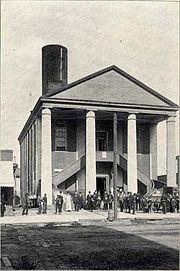
Some groups still pan for gold occasionally in local streams and creeks. The Reed Gold Mine operated until 1912. The Charlotte Mint was active until 1861, when Confederate forces seized it at the outbreak of the Civil War. The mint was not reopened at the war's end, but the building, albeit in a different location, now houses the Mint Museum of Art.
The city's first boom came after the Civil War, as a cotton processing center and a railroad hub. Charlotte's city population at the 1880 Census grew to 7,084. Population grew again during World War I, when the U.S. government established Camp Greene north of present-day Wilkinson Boulevard. Many soldiers and suppliers stayed after the war, launching an urban ascent that eventually overtook older city rivals along the arc of the Carolina Piedmont.
The city's modern-day banking industry achieved prominence in the 1970s and 1980s, largely under the leadership of financier Hugh McColl. McColl transformed North Carolina National Bank (NCNB) into a formidable national player that through aggressive acquisitions became known as NationsBank, eventually merging with BankAmerica to become Bank of America. Wachovia experienced similar growth, and was acquired by San Francisco-based Wells Fargo. Measured by control of assets, Charlotte is the second largest banking headquarters in the United States after New York City.
On September 22, 1989, the city took a direct hit from Hurricane Hugo. With sustained winds of 69 mph (111 km/h) and gusts of 87 mph (140 km/h) in some locations, Hugo caused massive property damage, destroyed 80,000 trees, and knocked out electrical power to most of the population. Residents were without power for weeks and cleanup took months. The city was caught unprepared; Charlotte is 200 miles inland, and residents from coastal areas in both Carolinas often wait out hurricanes in Charlotte.
In December 2002, Charlotte and much of central North Carolina were hit by an ice storm (which some dubbed "Hugo on Ice") that resulted in more than 1.3 million people losing power. During an abnormally cold December, many were without power for weeks. Much of the damage was caused by Bradford pear trees, splitting apart under the weight of the ice.
According to the United States Census Bureau, the city has a total area of 297.68 square miles (771.0 km2), of which 297.08 square miles (769.4 km2) is land and 0.6 square miles (1.6 km2) is water. Charlotte lies at an elevation of 748 feet (228 m), as measured at Charlotte/Douglas International Airport.
Charlotte constitutes most of Mecklenburg County in the Carolina Piedmont. Charlotte center city sits atop a long rise between two creeks, Sugar Creek and Irwin Creek and was built on the gunnies of the St. Catherine's and Rudisill gold mines.
Though the Catawba River and its lakes lie several miles west, there are no significant bodies of water or other geological features near the city center. Consequently, development has neither been constrained nor helped by waterways or ports that have contributed to many cities of similar size. The lack of these obstructions has contributed to Charlotte's growth as a highway, rail, and air transportation hub.
Charlotte, like much of the southeastern United States, has a humid subtropical climate (Koppen Cfa), with four distinct seasons. Winters are short and generally cool, with a January daily average of 41.7 °F (5.389 °C). On average, there are 58 nights per year that drop to or below freezing, and only 2 days that fail to rise above freezing. April is the driest month, with an average of 2.95 inches (7.5 cm) of precipitation. Summers are hot and humid, with a daily average in July of 80.3 °F (26.8 °C). There are 40 days per year with highs at or above 90 °F (32 °C). Autumn is generally drier than spring. In 2010 Charlotte saw its first White Christmas since 1974 measuring 3.5 inches.
The highest recorded temperature was 106 °F (41 °C) on July 1, 2012. The lowest recorded temperature was na5 °F ( na21 °C) on December 30, 1880; February 14, 1899; and January 21, 1985. Charlotte is directly in the path of subtropical moisture from the Gulf of Mexico as it heads up the eastern seaboard, thus the city receives ample precipitation throughout the year but also many clear, sunny, and pleasantly warm days. On average, Charlotte receives 43.5 inches (1,100 mm) of precipitation annually, with January and March being the wettest months, including an average of 5.2 inches (13 cm) of snow with more frequent ice storms and sleet mixed in with rain. These storms can have a major impact on the area, as they often pull tree limbs down on power lines and make driving hazardous.
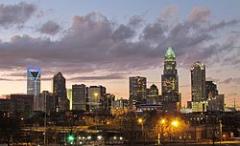
Charlotte has 199 neighborhoods radiating in all directions from Uptown. Biddleville, the primary historic center of Charlotte's African-American community, is west of Uptown, starting at the Johnson C. Smith University campus and extending to the airport. East of the plaza and north of Central Avenue, Plaza-Midwood is known for its international population, including East Europeans, Greeks, Middle-Easterners, and Hispanics. North Tryon and the Sugar Creek area include several Asian-American communities. NoDa (North Davidson), south of East Boulevard, is an emerging center for arts and entertainment. Myers Park, Dilworth, and Eastover are home to some of Charlotte's oldest and largest houses, on tree-lined boulevards, with Freedom Park, arguably the city's favorite, nearby.
In 2012 the urban section of Little Sugar Creek Greenway was completed. Inspired in part by the San Antonio River Walk, and integral to Charlotte's extensive urban park system, it is "a huge milestone" according to Gwen Cook, greenway planner for Mecklenburg County Park and Recreation.
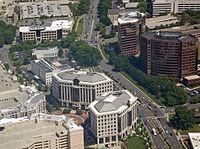
Park Road and the SouthPark area have an extensive array of shopping and dining offerings, with SouthPark essentially serving as a second urban core. A prominent feature of the Southpark neighborhood is the 120 aaacre Park Road Park. Far South Boulevard is home to a large Hispanic community. Many students, researchers, and affiliated professionals live near UNC Charlotte in the northeast area known as University City.
The large area known as Southeast Charlotte is home to many golf communities, luxury developments, mega-churches, the Jewish community center, and private schools. As undeveloped land within Mecklenburg has become scarce, many of these communities have expanded into Weddington and Waxhaw in Union County. Ballantyne, far south Charlotte, and nearly every area on the I aa485 perimeter, have seen extensive growth over the past 10 years.
Since the 1980s in particular, Uptown Charlotte has undergone massive construction of buildings housing Bank of America, Wells Fargo, Hearst Corporation, Duke Energy, several hotels, and multiple condominium developments.
As of 2012, census estimates show 772,627 people living within Charlotte's city limits, and 935,304 in Mecklenburg County. The Combined Statistical Area of Charlotte-Gastonia-Salisbury, NC-SC had a population of 2,338,289. Figures from the more comprehensive 2000 census show Charlotte's population density to be 861.9/km ² (2,232.4/sq mi). There are 230,434 housing units at an average density of 951.2 per square mile (367.2/km ²).
According to the 2010 United States Census, the racial composition of Charlotte was:
In 1970 the Census Bureau reported Charlotte's population as 30.2% Black and 68.9% non-Hispanic White.
The median income for a household in the city is $48,670, and the median income for a family is $59,452. Males have a median income of $38,767 versus $29,218 for females. The per capita income for the city is $29,825. 10.6% of the population and 7.8% of families are below the poverty line. Out of the total population, 13.8% of those under the age of 18 and 9.7% of those 65 and older are living below the poverty line.
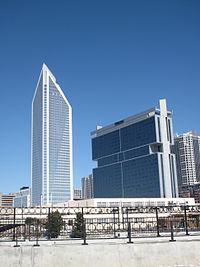
Charlotte has become a major U.S. financial center and is now the second largest banking center in the United States (after New York). The nation's second largest financial institution by assets, Bank of America, calls the city home. The city was also the former corporate home of Wachovia until its 2008 acquisition by Wells Fargo in San Francisco CA; Wells Fargo integrated legacy Wachovia, with the two banks fully merged at the end of 2011, which included transitioning all of the Wachovia branches in the Carolinas to Wells Fargo branches by October 2011. Since then, Charlotte became the regional headquarters for East Coast Operations of Wells Fargo, headquartered in San Francisco, California. Charlotte also serves as the headquarters for Wells Fargo's capital markets activities including sales and trading, equity research, and investment banking. Bank of America's headquarters, along with other regional banking and financial services companies, are located primarily in the Uptown central business district.
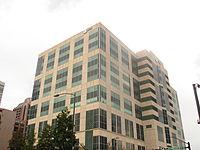
The following Fortune 500 companies are headquartered in the Charlotte metropolitan area, in order of their rank: Bank of America, Lowe's in suburban Mooresville, Nucor (steel producer), Duke Energy, Sonic Automotive, Family Dollar, Goodrich Corporation, SPX Corporation (industrial technology), Domtar (in suburban Fort Mill), Chiquita Brands International (which announced on November 29, 2011, it was relocating its headquarters to Charlotte from Cincinnati). Other major companies headquartered or with corporate operations in Metro Charlotte include: Extended Stay Hotels, Babcock and Wilcox, RSC Brands, TIAA-CREF, Time Warner Cable (formerly a business unit of Fortune 500 company Time Warner), Speed Channel, ESPNU, Continental Tire the Americas, LLC., Muzak, Belk, Harris Teeter, Meineke Car Care Center, Lance, Inc, Carolina Foods Inc, Bojangles', Carlisle Companies, Electrolux, LendingTree, Compass Group USA, Food Lion, and Coca-Cola Bottling Co. Consolidated (the nation's second largest Coca-Cola bottler). U.S. Airways regional carrier CCAir was headquartered in Charlotte.
Carowinds Amusement Park, owned by Cedar Fair Entertainment Company is located in Charlotte.
Charlotte is also a major center in the U.S. motorsports industry, housing multiple offices of NASCAR as well as the NASCAR Hall of Fame. Approximately 75% of the NASCAR industry's employees and drivers are based nearby. The large presence of the racing technology industry along with the newly built NHRA dragstrip, zMAX Dragway at Concord, is influencing other top professional drag racers to move their shops to Charlotte as well. The Metrolina Speedway is expected to bring more local racing along with a skate park, shoppes, restaurants, and an upscale hotel.
Located in the western part of Mecklenburg County is the U.S. National Whitewater Center, which consists of man-made rapids of various degrees and is open to the public year round.
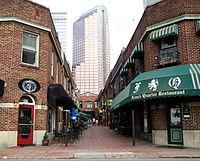
The Charlotte Region has a major base of energy-oriented organizations and has become known as auCharlotte USA ae The New Energy Capital. au In the region there are more than 240 companies directly tied to energy sector collectively employing more than 26,400. Since 2007 more than 4,000 energy sector jobs have been announced. Major energy players in Charlotte include AREVA, Babcock and Wilcox, Duke Energy, Electric Power Research Institute, Fluor, Metso Power, Piedmont Natural Gas, Siemens Energy, Shaw Group, Toshiba, URS Corp., and Westinghouse. The University of North Carolina at Charlotte has a reputation in energy education and research and its auEnergy Production and Infrastructure Center au trains energy engineers and conducts research.
The area is an increasingly growing trucking and freight transportation hub for the East Coast.
The Charlotte Center city has seen remarkable growth over the last decade. Numerous residential units continue to be built uptown, including over 20 skyscrapers under construction, recently completed, or in the planning stage. Many new restaurants, bars and clubs now operate in the Uptown area. Several projects are transforming the Midtown Charlotte/Elizabeth area.
Charlotte has a council-manager form of government. The Mayor and city council are elected every two years, with no term limits. The mayor is ex officio chairman of the city council, and only votes in case of a tie. Unlike other mayors in council-manager systems, Charlotte's mayor has the power to veto ordinances passed by the council; vetoes can be overridden by a two-thirds majority of the council. The council appoints a city manager to serve as chief administrative officer.
Unlike some other cities and towns in North Carolina, elections are held on a partisan basis. The current mayor of Charlotte is Anthony Foxx, a member of the Democratic Party.
Charlotte tends to lean Democratic, but voters are friendly to moderates of both parties. Republican strength is concentrated in the southeastern portion of the city, while Democratic strength is concentrated in the south-central, eastern and northern areas.
The city council comprises 11 members (7 from districts and 4 at-large). Democrats currently control the council with an advantage of 8 aato aa3. Of the at-large seats, Democrats won three out of four in the last election. While the city council is responsible for passing ordinances, many policy decisions must be approved by the North Carolina General Assembly as well, since North Carolina municipalities do not have home rule. Since the 1960s, however, municipal powers have been broadly construed.
Charlotte is split between three congressional districts on the federal level aethe 8th, represented by Democrat Larry Kissell; the 9th, represented by Republican Sue Myrick; and the 12th, represented by Democrat Mel Watt.
Charlotte was selected in 2011 to host the 2012 Democratic National Convention, which was held at the Time Warner Cable Arena. It began September 4, 2012, and ended on the sixth.
Emergency medical services for the City of Charlotte are provided by MEDIC, the Mecklenburg EMS Agency. MEDIC responded to over 93,000 calls for help in 2008, and transported over 71,000 patients to the major hospitals in Charlotte. The Agency employs nearly 350 Paramedics, EMTs, and EMDs. In addition to dispatching Medic aos EMS calls, the Agency also dispatches all county fire calls outside of the city of Charlotte. At any given time, between 20 and 40 ambulances will be deployed to cover the county.
CMPD is a combined jurisdiction agency. The CMPD has law enforcement jurisdiction in both the City of Charlotte, and the few unincorporated areas left in Mecklenburg County. The other small towns maintain their own law enforcement agencies for their own jurisdictions. The Department consists of approximately 1,700 sworn law enforcement officers, 550 civilian personnel, and more than 400 volunteers. The Charlotte-Mecklenburg Police Department divides the city into 13 geographic areas, which vary in size both geographically and by the number of officers assigned to each division.
The total crime index for Charlotte is 589.2 crimes committed per 100,000 residents as of 2008 and has shown a steady decline since 2005. The national average is 320.9 per 100,000 residents.
According to the Congressional Quarterly Press; '2008 City Crime Rankings: Crime in Metropolitan America, Charlotte, North Carolina ranks as the 62nd most dangerous city larger than 75,000 inhabitants. However, the entire Charlotte-Gastonia Metropolitan Statistical Area ranked as 27th most dangerous out of 338 metro areas.
The city's public school system, Charlotte-Mecklenburg Schools, is the second largest in North Carolina and 20th largest in the nation. In 2009 it won the NAEP Awards, the Nation's Report Card for urban school systems with top honors among 18 city systems for 4th grade math, 2nd place among 8th graders. An estimated 132,000 students are taught in 161 separate elementary, middle, and high schools.
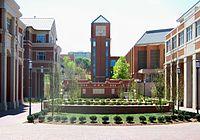
Charlotte is home to a number of notable universities and colleges such as Central Piedmont Community College, Charlotte School of Law, Johnson C. Smith University, Johnson & Wales University, Queens University of Charlotte, and the University of North Carolina at Charlotte. Several notable colleges are located in the metropolitan suburbs. In Davidson, Davidson College is ranked in the top 10 nationally among liberal arts colleges according to U.S. News & World Report. Additional colleges in the area include Belmont Abbey College in the suburb of Belmont, North Carolina, and Wingate University in the suburb of Wingate, North Carolina. Also nearby are Winthrop University, Clinton Junior College and York Technical College in Rock Hill, South Carolina.
UNC Charlotte is the city's largest university. It is located in University City, the northeastern portion of Charlotte, which is also home to University Research Park, a 3,200 acres (13 km2) research and corporate park. With more than 25,000 students, UNC Charlotte is the fastest-growing university in the state system and the fourth largest.
Central Piedmont Community College is the largest community college in the Carolinas, with more than 70,000 students each year and 6 campuses throughout the Charlotte-Mecklenburg region. CPCC is part of the statewide North Carolina Community College System.
The Charlotte School of Law opened its doors in Charlotte in 2006 and was fully accredited by the American Bar Association in 2011. The law school offers the Juris Doctor degree and has affiliated programming with UNC Charlotte and Johnson C. Smith University. Charlotte School of Law is the largest law school in the Carolinas.
Pfeiffer University has a satellite campus in Charlotte. Wake Forest University, with its main campus in Winston-Salem, North Carolina, also operates a satellite campus of its Babcock Graduate School of Management in the SouthPark area. Wake Forest is currently looking to move the campus to Uptown Charlotte. The Connecticut School of Broadcasting, DeVry University, and ECPI University all have branches in Charlotte. The Universal Technical Institute has the NASCAR Technical Institute in nearby Mooresville, serving the Charlotte area. Montreat College maintains a School of Professional and Adult Studies in the city.
The Public Library of Charlotte and Mecklenburg County serves the Charlotte area with a large collection (more than 1.5 million) of books, CDs and DVDs at 15 locations in the city of Charlotte, with branches in the surrounding towns of Matthews, Mint Hill, Huntersville, Cornelius and Davidson. All locations provide free access to Internet-enabled computers and WiFi, and a library card from one location is accepted at all 20 locations.
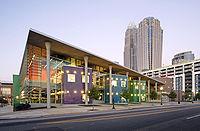
Although the Library's roots go back to the Charlotte Literary and Library Association, founded on January 16, 1891, the state-chartered Carnegie Library which opened on the current North Tryon site of the Main Library was the first non-subscription library opened to members of the public in the city of Charlotte. The philanthropist Andrew Carnegie donated $25,000 dollars for a library building on the condition that the city of Charlotte donate a site, and $2500 per year for books and salaries, and that the state grant a charter for the library. All conditions were met, and the Charlotte Carnegie Library opened in an imposing classical building on July 2, 1903.
The 1903 state charter also required a library be opened for the disenfranchised African-American population of Charlotte. This was completed in 1905, with opening of the Brevard Street Library for Negroes, an independent library in Brooklyn, a historically black area of Charlotte, on the corner of Brevard and East Second Street (now Martin Luther King Boulevard). The Brevard Street Library was the first library for free blacks in the state of North Carolina, some sources say in the southeast. This library was closed in 1961 when the Brooklyn neighborhood in Second Ward was redeveloped, but its role as a cultural center for African-Americans in Charlotte is continued by the Beatties Ford branch, and the West branch of the current library system, as well as by Charlotte's African-American Cultural Center.
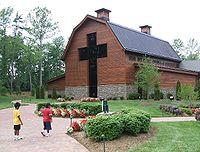
The birthplace of Billy Graham (Charlotte is the historic seat of Southern Presbyterianism), but the changing demographics of the city's increasing population have brought scores of new denominations and faiths. The Billy Graham Evangelistic Association, Wycliffe Bible Translators' JAARS Center, and SIM Missions Organization make their homes in Charlotte. In total, Charlotte proper has 700 places of worship.
The Baptist Peace Fellowship of North America is headquartered in Charlotte, and both Reformed Theological Seminary and Gordon-Conwell Theological Seminary have campuses there; more recently, the Religious Studies academic departments of Charlotte's local colleges and universities have also grown considerably.
The largest Christian Church in Charlotte by attendance is Elevation Church, a six year old Southern Baptist church plant, founded by lead pastor Steven Furtick. The church has over 10,000 congregants at seven Charlotte locations.
Charlotte's Cathedral of Saint Patrick is the seat of the bishop of the Roman Catholic Diocese of Charlotte. The Traditional Latin Mass is offered by the Society of St. Pius X at St. Anthony Catholic Church in nearby Mount Holly. The Traditional Latin Mass is also offered at St. Ann, Charlotte, a church under the jurisdiction of the Roman Catholic Bishop of Charlotte.
The Greek Orthodox Church's cathedral for North Carolina, Holy Trinity Cathedral, is located in Charlotte.
Charlotte has the largest Jewish population in the Carolinas. Shalom Park, in south Charlotte, is the hub of the Jewish community, featuring two synagogues Temple Israel (Charlotte, North Carolina) and Temple Beth El as well as a community center and the Charlotte Jewish Day School for grades K-5.
Most African Americans in Charlotte are Baptists affiliated with the National Baptist Convention the largest predominantly African American denomination in the United States. African American Methodists are largely affiliated with either the African Methodist Episcopal Zion Church whose headquarters is in Charlotte or the African Methodist Episcopal Church. African American Pentecostals are represented by several organizations such as the United House of Prayer for All People, Church of God in Christ and the United Holy Church of America.
Charlotte is also the headquarters of the Advent Christian Church.
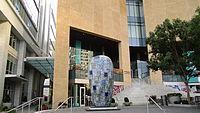
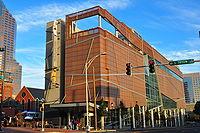
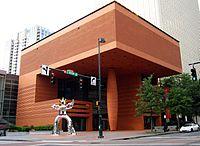
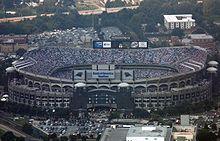
Charlotte is currently home to two major professional sports franchises: the Carolina Panthers of the National Football league, and the Charlotte Bobcats of the National Basketball Association (NBA). The Panthers have been located in Charlotte since their creation in 1995, and the Bobcats have been located in Charlotte since their creation in 2004. The Panthers play their home games in Bank of America Stadium, while the Bobcats play in the Time Warner Cable Arena; both venues are located in Uptown Charlotte. From 1988 to 2002, Charlotte hosted an NBA franchise named the Charlotte Hornets, but the franchise relocated to New Orleans, Louisiana in 2002 after bitter animosity between the team's fans and principal owner George Shinn.
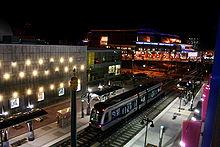
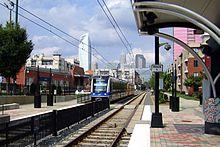
The Charlotte Area Transit System (CATS) is the agency responsible for operating mass transit in Charlotte and Mecklenburg County. CATS operates light rail transit, historical trolleys, express shuttles, and bus services serving Charlotte and its immediate suburbs. The LYNX light rail system comprises a 9.6 aamile line north-south line known as the Blue Line, which saw 2025 ridership projections (18,500) exceeded after its first year of service. Bus ridership continues to grow (66% since 1998). The 2030 Transit Corridor System Plan looks to supplement established bus service with light rail and commuter rail lines as a part of the system LYNX. Currently the City of Charlotte and CATS Staff are conducting public forums to present the Final Environmental Impact Statement (EIS) and gather public input from residents, property owners and business owners located in Northeastern Charlotte which is where the LYNX light rail is proposed to be extended from uptown Charlotte to UNC aaCharlotte campus. See the BLE Home Page for further details.
A 2011 study by Walk Score ranked Charlotte the 49th most walkable of the fifty largest cities in the United States.
Charlotte's central location between the population centers of the northeast and southeast has made it a transportation focal point and primary distribution center, with two major interstate highways, I aa85 and I aa77, intersecting near the city's center. Charlotte's beltway, designated I aa485 and simply called "485" by locals, is partially finished but funding has been slow in coming. The new projection has it slated for completion by 2013. Upon completion, 485 will have a total circumference of approximately 67 miles (108 km). Within the city, the I aa277 loop freeway encircles Charlotte's uptown (usually referred to by its two separate sections, the John Belk Freeway and the Brookshire Freeway) while Charlotte Route 4 links major roads in a loop between I aa277 and I aa485. Independence Freeway, which carries U.S. 74 and links downtown with the Matthews area is undergoing an expansion and widening in the eastern part of the city.

Charlotte/Douglas International Airport is the sixth busiest airport in both the U.S. and the world overall as measured by traffic (aircraft movements). It is served by many domestic airlines, as well as international airlines Air Canada, Insel Air, and Lufthansa, and is the largest hub of US Airways. Nonstop flights are available to many destinations across the United States, as well as flights to Canada, Central America, the Caribbean, Europe, Mexico, and South America.
Charlotte is served daily by three Amtrak routes:
The city is currently planning a new centralized multimodial train station called the Gateway Station. It is expected to house the future LYNX Purple Line, the new Greyhound bus station, and the Crescent line that passes through Uptown Charlotte.
List of sister cities of Charlotte, designated by Sister Cities International:



Word Count: 5815





